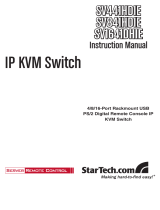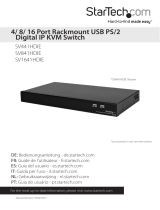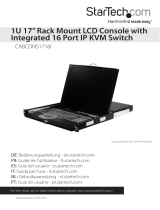Page is loading ...

Chapter 1 Product Overview .............................................................................. 1
A. Introduction ..................................................................................................................................... 1
B. Package Contents .......................................................................................................................... 1
C. Optional .......................................................................................................................................... 1
Chapter 2 Your First Time on Digital KVM via IP ............................................. 2
A. Quick Start Guide ........................................................................................................................... 2
B. Disabling the Mouse Acceleration on the Host computer(s) and Client Computer ........................ 8
C. How to Connect your Digital KVM via IP ...................................................................................... 9
D. Access your Digital KVM via IP and Remote Control the Host Computer(s) ............................... 11
Chapter 3 Advanced Operations ....................................................................... 12
A. How to login the Digital KVM via IP .............................................................................................. 12
B. Configure your Digital KVM via IP ................................................................................................
14
I. How to Setup Personal Preferences……………………………………………………………… 14
II. How to Get the Snapshots………………………………………………………………………… 16
III. How to Remote Control the Host Computer(s)………………………………………………….. 17
IV. How to Setup the IP Address for your Digital KVM via IP ....................................................... 18
V. How to Edit the User Accounts ................................................................................................ 20
VI. How to Setup your Digital KVM via IP System Identification ................................................. 21
VII. How to Strengthen your Digital KVM via IP System Security ................................................ 22
VIII. How to Setup your Digital KVM via IP with the External Power Bar and Keyboard Mapping
................................................................................................................................................. 25
IX. How to Setup the SNMP Agent and Configuration .................................................................. 26
X. How to Setup RADIUS authentication ....................................................................................... 27
XI. How to Setup and Control the External Serial Consoles .......................................................... 28
XII. How to Set Date and Time ....................................................................................................... 29
XIII. How to Update your Firmware.................................................................................................. 30
XIV. How yo Upload Custom Certificate ........................................................................................... 32
XV. How to Lookup your Digital KVM via IP System Status ........................................................... 33
XVI. How to Setup Port Number ....................................................................................................... 34
XVII. How to Speed up your Digital KVM via IP .............................................................................. 35
Chapter 4 Accessing KVM Features ................................................................. 37
A. Cascade Configuration .................................................................................................... 37
B. KVM-OSD Operations ..................................................................................................... 38
C. Hot Key Commands ........................................................................................................ 41

Chapter 5 How to Remotely Control the Host computer(s) ............................ 43
A. Accessing the VNC Interface ......................................................................................................... 43
I. Web Interface ........................................................................................................................ 43
II. Native VNC Client .................................................................................................................. 43
III. SSH Tunnel............................................................................................................................ 43
B. Using the VNC Menu ......................................................................................................................
45
C. How to Use the Bribar .................................................................................................................... 45
D. How to Use the Main Menu ............................................................................................................ 47
E. How to Use the Virtkeys Menu ....................................................................................................... 48
F. How to Use the Video Tuning Menu ............................................................................................... 49
Appendices
Appendix A Troubleshooting ............................................................................................................... 50
Appendix B Specifications .................................................................................................................. 53
Appendix C Supported Protocols ........................................................................................................ 55
Appendix D Warranty Information ....................................................................................................... 56
Appendix E Regulatory Compliance Statements ................................................................................ 57
Appendix F About Security Certificate Warnings ............................................................................... 58
Appendix G Using Optional Serial Supervisor Module (IPMI supported) with the R-Port ............... 59
Appendix H Using Optional Modem Feature ...................................................................................... 67
NOTE: Since firmware for our Digital KVM via IP Products is constantly evolving to offer
more functionality and improvements, some of the options and instructions
presented in this manual may differ from your unit. To obtain the latest
documentation and support information for our Digital KVM via IP products,
please visit www.digitus.de

* Optional cables for PS/2 computers
DS-1921x
DS-1911x
1-to-3 cable for PS/2 compute
r
1-to-2 cable for USB compute
r

Chapter 1 Product Overview
A. Introduction
Thank you for purchasing DIGITUS
®
Digital KVM via IP series with integrated KVM. Using the
Internet or your TCP/IP enabled network, you can now remotely monitor and control critical PC servers
and workstations using an industry-standard Web browser or VNC client.
y RoHs compliant
y 16 bits color depth supports up 65,536 colors
y Unique OSD feature to guide the user finish the initial setup step-by-step very easily
y Different user accounts may have different preferences
y Firmware online upgradeable 24/7
y Custom certificate upload
y Flexible access sharing modes
y VNC screen encryption
y Internal firewall
y Supports industry-standard networking and management protocols such as TCP/IP and
SNMP
y Offers secure management options including SSL encryption, SSH tunneling, and RADIUS
authentication
y Platform independent: can be managed using any Java-enabled Web browser
y One remote management point for multiple computers
B. Package Contents
Y
our package should contain the following:
y 1 x Digital KVM via IP unit
y 1 x Power Adapter
y 1 x AC Cord for Power Adapter
y 1 x User’s Manual
y 1 x Rack Mount kit of Standard 19” 1U ( for 8/16 ports only )
y 1 x Screw Package ( for 8/16 ports only )
y DS-1911x (PS/2 cable) or DS-1921x (USB cable) x 4/8/16-port Model ( depends on the models )
y 1 x DB9 RS-232 null modem serial cable
C. Optional
y There are many different lengths for PS/2 or USB cables available:
1.8, 3.0, 6.0, 10.0, 15.0 m
y The Serial Supervisor -- Compatible with ALL models except DS-11215.
Serial Supervisor
1

Chapter 2 Your First Time on Digital KVM via IP
A. Quick Start Guide
For this Quick Start Guide, we offer two different easy step-by-step ways, letting you setup this unit
very quickly.
Before doing the initial setting:
I. Please make sure the latest Java software
downloaded at http://www.java.com on the client
computer.
II. Please disable the mouse acceleration on the host computer(s) AND client computer,
referring more detailed information on Chapter 2, section B Disabling the Mouse
Acceleration on the Host Computer(s) and Client Computer.
The First Way : Using the IP-OSD step-by-step menu (Recommended)
Hardware Necessary for this way
I. A Digital KVM via IP unit with a power adapter
II. A keyboard and monitor
III. A CAT-5 cable with RJ-45 connector
Step 1. Connect a PS/2 keyboard (see NOTE 2) and monitor to the local port of Digital KVM via IP.
NOTE 1: For the module unit, please connect it with the LCD console drawer, no need to
connect an external keyboard and monitor. The IP-OSD menu comes up automatically
on the front console drawer after power up.
2

Step 2. Connect a CAT-5 cable to the LAN port of Digital KVM via IP, making it online.
Step 3. Power up the monitor and Digital KVM via IP, the IP-OSD menu comes up automatically;
simply follow the step-by-step instructions to finish the initial setup. If you would like to bring
up the menu, please simply use your paperclip or pen to press the “IP SETUP” button.
3

The Second Way: Using the HyperTerminal via Serial Port
Hardware Necessary for this way
I. A Digital KVM via IP unit with a power adapter
II. A computer with a keyboard, mouse and monitor
III. A CAT-5 cable with RJ-45 connector
IV. A DB9 RS-232 null modem cable
Step 1. Connect the DB9 RS-232 null modem serial cable to the serial port of Digital KVM via IP.
And, connect the other end to the serial port (COM1, COM2…) of your computer.
4

Step 2. From your computer, select “HyperTerminal” as following.
Step 3. If you never setup your HyperTerminal before, it will ask you to input your phone area
code, please feel free to do so, and then click “OK”, you will get the following screen.
Please type any name you prefer, for example, “abc”.
5

Step 4. Choose the proper serial port you connect, for example, “COM1”.
Step 5. Change “Bits per second” to 115200.
6

Step 6. Press “Enter”, you will get the following screen.
Step 7. Follow the instruction on the screen. For example, simply type “I” for setting your IP, type “F”
for resetting everything back to factory defaults, and so on. Here is a reminder for you, please type “W”
after you made any change.
7

B. Disabling the Mouse Acceleration on the Host computer(s) and Client Computer
Many operating systems offer a feature called mouse acceleration that allows the user to adjust the
responsiveness of the cursor on the screen to physical movements of the mouse. While this is usually
a beneficial interface enhancement, it can interfere with the operation of the unit and should be
disabled on the managed computers before
a remote session is attempted. Follow the instructions
below to disable mouse acceleration for the operating system installed on each managed computer.
Windows 98 and Windows 2000
1. From the Control Panel, click on Mouse.
2. From Mouse Properties, click on Motion tab.
3. Make sure the Pointer speed bar is centered and Acceleration is set to None.
Windows XP and Windows Server 2003
1. From the Control Panel, click on Mouse.
2. Go to “Pointer Options “and turn off “Enhance Pointer Precision.”
3. Make sure that the Pointer speed bar is centered.
Windows Vista
1. From the Control Panel, click on Appearance and Personalization.
2. Click on Personalization.
3. Click on “Mouse Pointers”.
4. Go to “Pointer Options “and turn off “Enhance Pointer Precision.”
5. Make sure that the Pointer speed bar is centered.
Linux, Unix and X-Windows
1. Add this command to your xinitrc, xsession or other startup script:
xset m 0/0 0
Sun Solaris
1. Add this command to your xinitrc, xession or other startup script:
xset m 1/1 0
8

C. How to Connect your Digital KVM via IP
9

DS-14215: Ports PC 1~8/A~H
DS-13215: Ports PC 1~8 only
DS-11215: 1 Port
The restrictions on functions such as cascading and the assignment of master and slave units
also apply to all versions of the product.
1. Ensure that the Digital KVM via IP unit and the computers to be managed are powered off.
2. If desired, mount the unit in a standardized rack or cabinet.
3. Connect a standard straight-through Ethernet patch cable to the LAN port on the rear panel of the
unit.
4. Connect the opposite end to your network hub, switch, or terminated wall outlet.
5. If you wish to use the product as a local console, connect a standard keyboard (purple connector)
and mouse (green connector) to the PS/2 ports, as marked on the rear panel.
6. Connect a VGA monitor to the video-out port on the rear panel of the unit.
7. (a) If you are using PS/2 connections to your managed computers, connect the end of the
DS-1911x cable that has three connectors (keyboard, video, mouse) to the keyboard,
mouse, and VGA Out ports on a computer (often a server or other critical system).
Connect the opposite end (with a single VGA-style connector) to one of the PC 1~8/A~H
ports on the rear panel of the Digital KVM via IP. Repeat this procedure for each PS/2-
enabled managed computer. You will be able to add additional managed computers later
with the Digital KVM via IP powered on.
(b) If you are using USB connections to your managed computers, connect the end of the
DS-1911x cable that has two connectors (USB, video) to an available USB port and VGA
Out port on the computer (often a server or other critical system). Connect the opposite end
(with a single VGA-style connector) to one of the PC 1~8/A~H ports on the rear panel of the
Digital KVM via IP. Repeat this procedure for each USB-enabled managed computer. You
will be able to add additional managed computers later with the KVM powered on.
8. (For 8/16 ports only) please mount the brackets with the unit as following figure.
9. Power on the Digital KVM via IP by connecting the AC adapter to a suitable power source and
connecting the opposite end to the DC 12V port on the rear panel of the unit.
10. Power on each of the managed computers, observing normal startup procedures.
NOTE: You can choose to mix managed computers connected via PS/2 and USB connections as
necessary with no impact on features or functionality.
NOTE: Steps 5 and 6 are necessary only if you wish to have the ability to manage the KVM and its
computers locally (i.e. not over the Internet or LAN). While not required, adding these devices
is highly recommended for ease of administration.
NOTE: The KVM also has the ability to “cascade” multiple KVMs to increase the total number of
possible managed computers. If you wish to take advantage of this feature, refer to the
section “Cascade Configuration” in this manual.
10

D. Access your Digital KVM via IP and Remote Control the Host computer(s)
As soon as you finish the above initial settings and connections, congratulations! You are ready to
enjoy remote control the host computer(s) from any corner around the whole world! Simply open up
the web browser and type the IP you already setup in the Quick Start Guide and then type the right
username and password. That it! You’re successful to access your Digital KVM via IP! As you login
the Digital KVM via IP with the right username and password, you will get the following screen:
Please simply double click on the small square window in the middle of the screen. You’ll get the VNC
screen.( You may need to upgrade or download your Java support in your browser before using
the VNC screen to remote control the host computer(s); however, most modern browsers come
with a version of Java that is compatible with this application.) That is, you will see the screen of the
host computer(s). Now, you can fully control the host computer(s) remotely like you present at the host
computer(s) location physically, sitting in front of the host computer(s)! Certainly, if you would like to
log out your Digital KVM via IP, please simply click on the icon of “Logout” on the top of screen!
11

Chapter 3 Advanced Operations
The Web interface is the most intuitive way to configure the Digital KVM via IP. It also offers a Java-
based VNC client that you can use to control the managed computers from a remote location. The
Digital KVM via IP supports any industry-standard HTML Web browser. You can access the Web
interface by opening your Web browser and entering the IP address of the unit you wish to
access/configure. The IP address will be either
a) the address assigned for the LAN port by your DHCP server as identified in the previous section,
or
b) the fixed IP address you setup, see Quick Start Guide for more information. Again, the default IP
address of the LAN port of Digital KVM via IP is https://192.168.1.123
. Please remember to
add “s” after “http” which means this web page is under SSL 128 bits encryption
protection.
NOTE: Only the “admin” account have rights to change all of the following settings.
A. How to login the Digital KVM via IP
Step 1: The Login Screen
Before you can access the Web configuration interface, you must enter a username and password.
The default username and password as shipped from the factory is username admin with a password
of admin.
12

NOTE: Before the login screen appears, your Web browser may display a warning about an invalid
security certificate. This does not
affect the security of your data in any way. Whenever you are
prompted about a certificate security problem by your browser or the Java VNC client, always
choose the option to continue. .
Step 2: The Home Screen
The Home screen serves two functions. First, it is a place to check the status of the unit, view
essential system information, and capture screen shots from the managed computers. Second, it is
where you can start the integrated Java VNC client to interact with the managed computers by clicking
on the large screen shot or choosing one of the VNC client links.
13

B. Configure your Digital KVM via IP
The Home Screen
The menu list on the left hand side allows you to access all of the features to perform the configuration
of the Digital KVM via IP.
Each item is described in details as following:
I. How to Setup Personal Preferences
Different user accounts may have different personal preferences. It might be a good idea to have a
login account for “local” access and a different one for “remote” access. The “local” account would
select 16-bit color, max bandwidth, and so on. And, the “remote” account would select 8-bit color, low
bandwidth, no splash screen and require encryption. By selecting the correct login depends on the
application (i.e. login from home over WAN versus LAN login). As the following image shown, the
current user preferences are listed here as follows. You may change any of them and save with the
button below. Most of these preferences affect how the VNC client and server interact.
14

15

II. How to Get the Snapshots
As the following image shown, the user can get the screen snapshot of full size, half size, quarter size,
one-8
th
size, and one-16
th
size.
16

III. How to Remote Control the Host Computer(s)
Please simply click the “VNC Connect” to get the screen of host computer as the following image
shown. From here, you get the fully control on the host computer like you physically sit in front of the
host computer(s).
17
/





